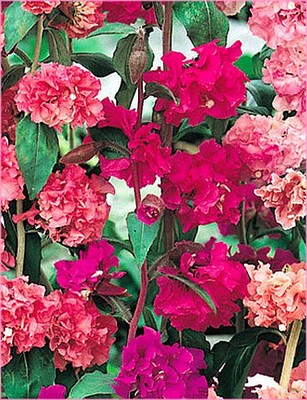By Beatrice Hawkins
I have found a plant new to me in an email I receive from time to time from an American seed company. It sounds as if it would be perfect in my garden.
Clarkias sound and look great. They are an annual. They don’t like overly fertile soil or require fertilising, they like very well drained soil (my garden is mostly sandy), they are very drought tolerant, they self seed readily and come back every year with no need for me to do anything. The flowers look lovely, they come in a wide range of shades of pink in singles, semi-doubles and doubles in the pictures I’ve seen. The height is from 30-60cm, the spread is about 20cm and they flower from late spring through until the cold weather comes in full sun or semi shade. Some of the new improved varieties also claim to have very strong stems and are ideal as a cut flower … sound perfect!! A common name is “farewell to spring” and is indicative of the flowering time.
They are native to the pacific coast of America and were discovered there by the Lewis and Clark, 1804-1806 expedition, hence the name. Another explorer, William Davis, rediscovered them in 1823, spread the seed and after this they became popular as a garden flower.
In Australia they appear to be called by various names but Garland flower seems to be a common one and maybe Godetia is another one. The Australian colour range seems to be much better than the American being from light pink through to deep red and purples and many bi colours. I will try and get some to plant in autumn and see if I can get them going in my garden. Of course I will only try to source from Australian suppliers.
When I was in WA with my daughter we, of course, did quite a bit of gardening. She was landscaping an area around her pool. As they live in an area where tank water is the only option, they have a great black and grey water system. The black water is fully treated and then applied by an underground system to a small area of lawn that is often the only green space to be seen anywhere!
We planted a lot of grevilleas of all sorts and colours to attract birds and bees, (they have a hive in the orchard), some succulents and natives in the retaining wall and picked up some beautiful blue Felicia amelloides and “blue eyed beauty” osteospermums. These were planted together in an area out from the bedroom window and I look forward to seeing photos as they spread – the bright blue and yellow should make a great show.
Large areas around the house are gravelled as, because of the climate and the limited water supply, large areas of lawn is not really an option. Different colours and sizes have been used to great effect. As you can tell I am quite proud of her efforts.
The vegetable garden is grown in self watering wicking beds that she has made from those plastic water tanks that we see everywhere lately on utes and trailers as people cart water for stock. My son gets molasses in them for stock supplements. My son in law is not a gardener or handy man so my practical and ingenious daughter and the children do it all.
My daughter has cut them in half, put broken bricks, rough rock and the like as a layer in the base, a layer of netting and then geocloth or shade cloth over this and the soil on top. There is a pipe down one corner so the rock filled reservoir can be kept topped up with water and this then wicks up to the soil. My grandson has been sending me photo updates of how it is all going as it is his job to make sure it is all kept operating correctly! Tomatoes, beans, snow peas, corn and potatoes are all doing well. While I was there we were picking broccoli and other vegetables from some of these beds. They also have an aquaponics set up in a shade house, as well as chooks, ducks and geese! To keep the poultry safe from foxes, Hugo the kelpie has a run between the two yards… works well.
Christmas is fast approaching and if you have a gardener on your list maybe some rewetting granules to add to their garden beds and pot plants might be an idea. I am going to my local nursery to get some today as, with the limited water available from my shower, I am afraid my pot plants have become hydrophobic and the water tends to just run straight through taking the nutrients with it and making a mess on the tiles on the patio. Apparently I can apply these granules to the top of the pot and they will help the soil to retain the water but they will not become water logged. They sound like a great idea to add to all areas, gardens and lawns alike. I won’t bother with the lawn until we have some water in the dams as, at the moment, there is no water available for that. I’ll let you know over the next weeks how it works on my pot plants.







